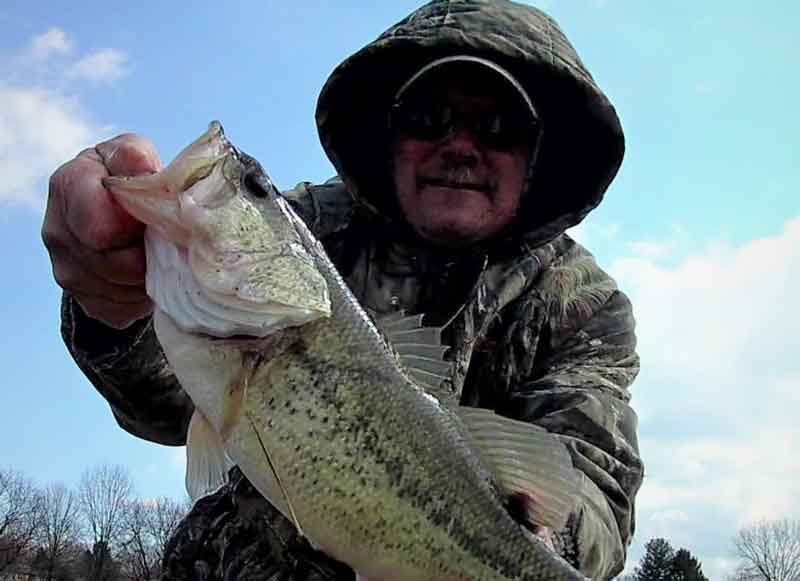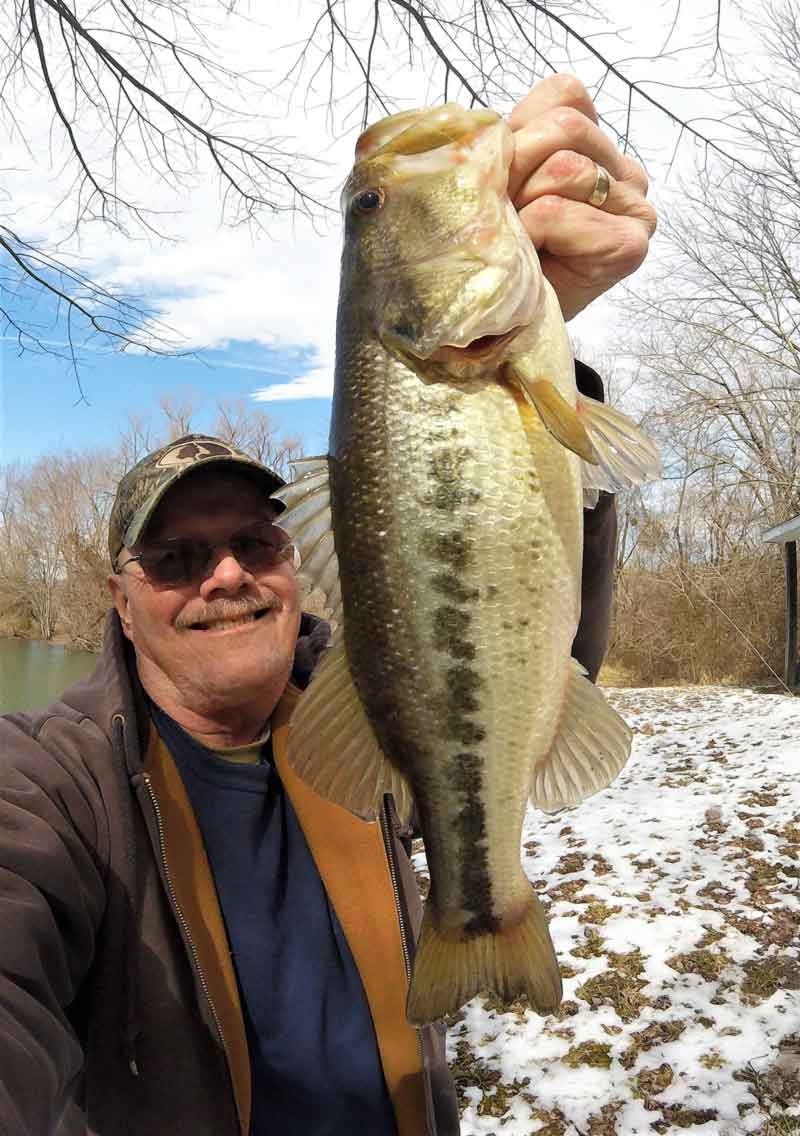Many anglers look forward to the bass spawn and the ice had not been off the small lake more than two or three days, but I just had to try and see if I could catch a decent largemouth bass a bit earlier int he season than usual. It was a “quick hit” trip due to my work schedule, and I only had about an hour to test the waters. My lure choice was pretty simple, a number-five Mepps Aglia with a gold blade and a half-ounce Bill Lewis Rat-L-Trap in a shad finish. In most waters, the Mepps would imitate a golden shiner and the lipless crank bait would be code for shad species – both favorite early-season, cold-water forage for late winter to early spring largemouths. The big in-line spinner didn’t yield a strike after 20 casts or so and I grabbed the Rat-L-Trap for a change-up. On the very first cast I felt slack in the line and set the hook to what turned out to be a two-pound class largemouth bass that sported dark, distinctive markings, and red lips and tooth pads – a cold-water trait. Not the pudgy, pre-spawn female I was hoping for, but I was at least encouraged that fish would strike a quick-moving bait in the 41-degree water. Another half-hour of casting yielded a pair of bass, one a plump three-pounder.

That brief, last-minute trip many years ago taught me a number of things about ice-out bass that I previously had not realized. For one, bass were willing to strike a fast-moving bait with gusto despite the low water temperatures. Two, it made me think the fish exhibited reaction strikes with the lure speed. And finally, these fish were in shallow, sun-warmed areas only three feet deep, even though many anglers fish deep and terribly slow in these sorts of conditions.
Over the next 20 years I developed a game plan to hit a variety of small, local waters each March, sometimes earlier, to jump the gun for spring bass.
Weather Pattern's Effect on Largemouth Bass Fishing
After the ice comes off, bass can position themselves in amazingly shallow water when the weather factors align. The combinations of sun, wind, and warm rain can put fish at your fingertips where they will activate and strike aggressively. A few days of 50- to 60-degree temperatures with bright sunlight can warm surface water a few degrees, and wind action can accumulate this warmer body of water along windward shorelines. This usually occurs when southerly winds prevail, but it doesn’t have to be on a south wind. It can occur anywhere there is shallow, sun-drenched conditions. Rip-rap causeways, shallow coves, and flats can heat up quickly by several degrees and draw plankton, baitfish, and bass. Thermal banking is nothing new, but it only takes a few degrees of warmth to get bass up shallow. Additionally, never overlook sun-soaked stretches of shoreline that have boulders and rocks that can hold the heat from several hours of bright sunshine. Such areas can be as much as three to five degrees warmer than surrounding water, thus becoming a magnet for the bass.

Warm rain can certainly concentrate cold water bass to areas of incoming precipitation, where the water is again several degrees warmer than the rest of the environment. Sometimes, slightly turbid, off-color water can be a plus for fishing as vibrating lures such as chatterbaits, spinnerbaits, and lipless cranks can again draw hard reaction strikes from shallow-moving fish. Some of the fastest fishing I have ever enjoyed on bass was in these conditions, where incoming streams, ditches, and spillways concentrated the fish in a very small area. Don’t let the muddy water scare you, and remember that this is a time when big pre-spawn fish lose their caution and can be caught in a variety of ways.
Tackle for Ice-Out Bass
Most bass anglers favor medium baitcasting gear and 12- to 20-pound fluorocarbon lines for tossing larger profile vibrating baits like those mentioned earlier. However, when I can get away with it, I prefer medium light spinning gear with a seven-foot rod that has a sensitive tip yet good backbone for setting hooks. Sometimes you may get a strike at the end of a long cast and a responsive hookset with 15- to 20-pound braided line can get the hookup needed on a four-pound or larger fish. Since this is not the finesse bite that will come later in the season, most strikes will be either solid thumps or they may knock slack in your line. The lack of stretch in braids and the toughness of a 15-pound test fluorocarbon leader will team nicely for throwing half- and three-quarter-ounce spinnerbaits, chatterbaits and in-line spinners, yet still provide sensitivity for working slower retrieves with suspended jerk baits like the Lucky Craft Pointer Series in 100 and 120 lengths.
Sometimes, prime late-winter/early spring areas for shallow moving bass are in tough, wooded coves and flats where bigger, stronger tackle is needed for success. Upping the ante to 30- to 50-pound braid or heavier fluoro leaders may be needed to extract big fish out of the tangles and into your hand for those treasured photos. Generally it’s a personal choice when it comes to tackle preferences, but keep in mind that in this scenario the goal is to get fish away from those snags as quickly as possible.
On a final note, realize that the early spring bite on largemouths is frequently a hit-or-miss, feast-or-famine gig with an emphasis on the chance for what may be your biggest bass of any given year. Don’t let a skunk discourage you. The fish are usually hungry from a long winter and it only takes a few degrees of warming water to trigger a good bite. So this year, jump the gun for a shot at a trophy.
-By Jim Gronaw